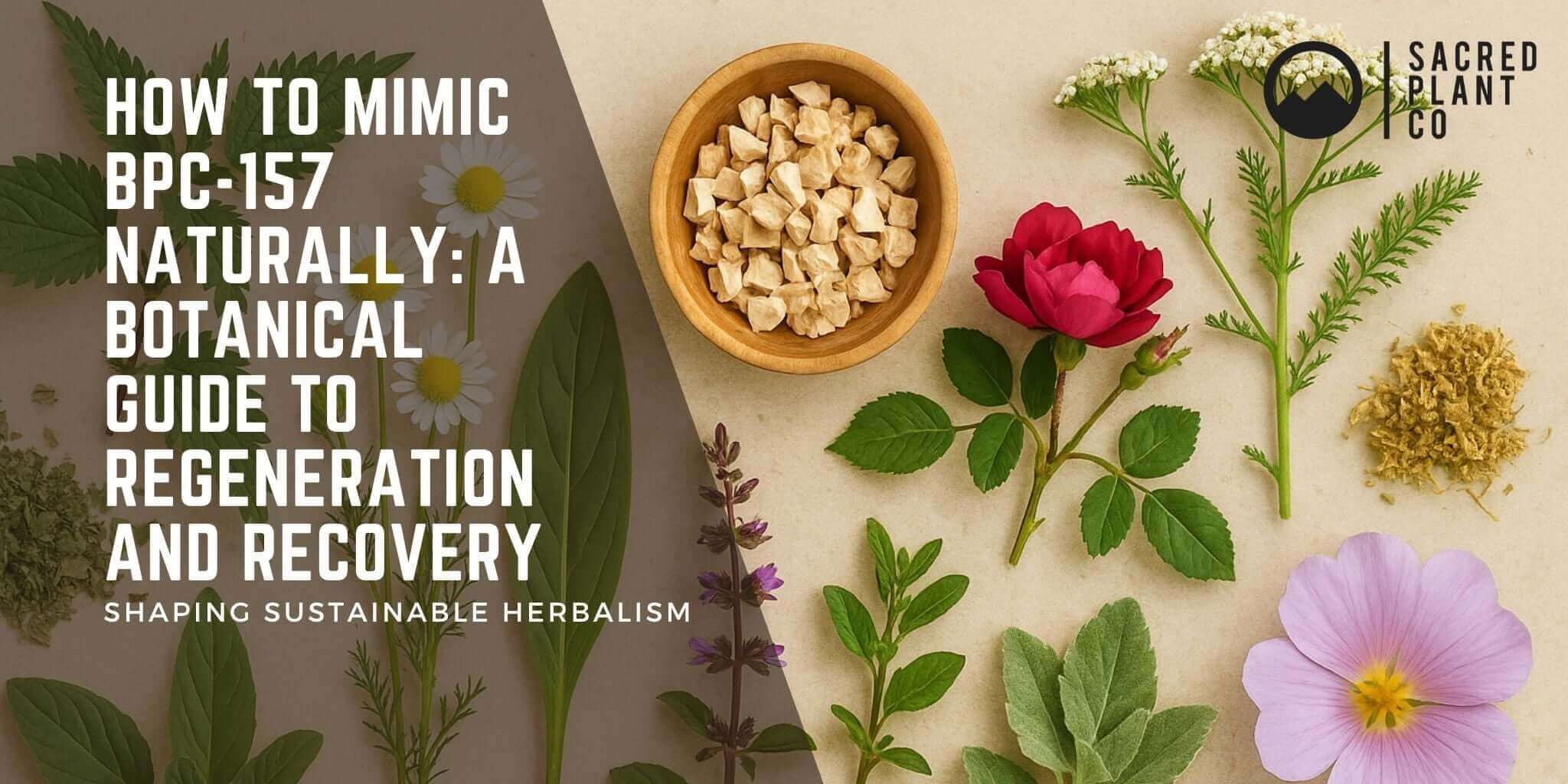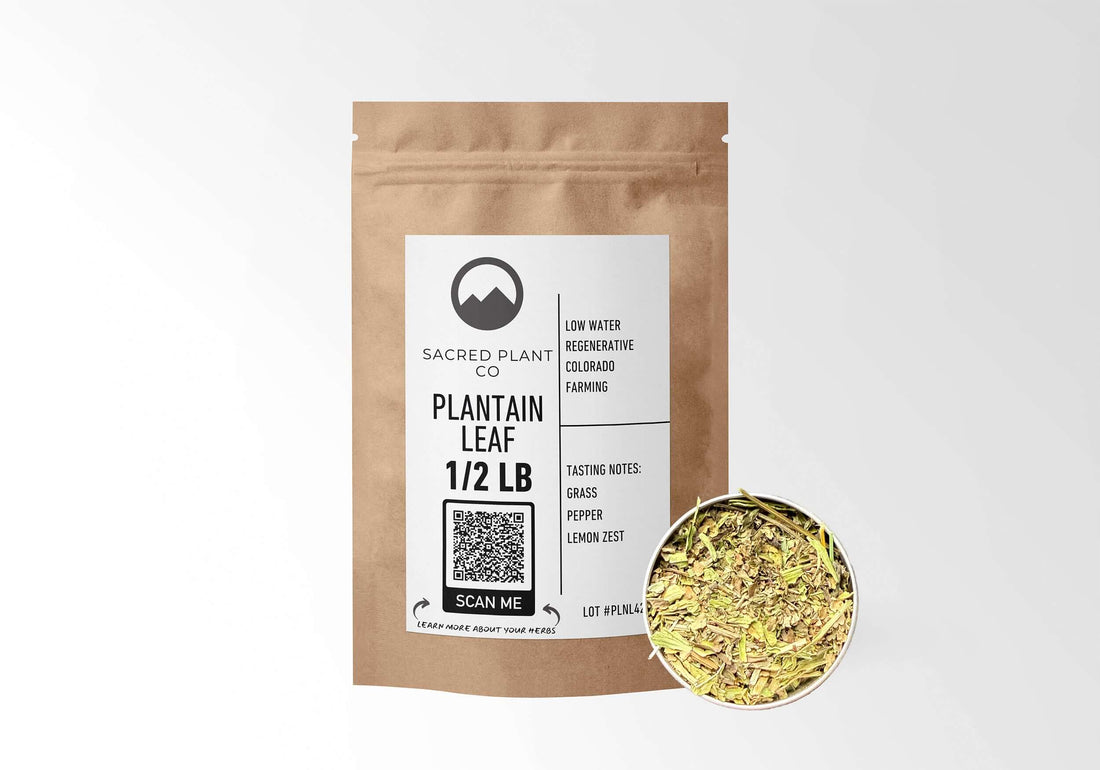Plant-Based Healing Protocol with Herbs That Mimic BPC-157
What is BPC-157?
BPC-157, or Body Protection Compound-157, is a synthetic peptide derived from a sequence of amino acids found naturally in human gastric juices. Originally researched for its healing effects on ulcers, connective tissue injuries, and inflammation, BPC-157 has quickly gained attention for its systemic regenerative properties. Athletes and biohackers often use it to accelerate recovery from tendon, ligament, muscle, and gut injuries. It has even shown promise in promoting angiogenesis (new blood vessel formation), protecting organs, and countering damage caused by NSAIDs.
Many of BPC-157's effects mirror what traditional herbalism has achieved for centuries.
At Sacred Plant Co, we believe the body doesn’t need synthetic instructions when nature has already provided the original code. Our goal isn’t to mimic peptides with plants. It’s to rediscover the healing rhythm that nature wrote into the very soil. Below is our comprehensive, four-phase herbal protocol that follows the same physiological arc as BPC-157—designed to restore gut integrity, rebuild connective tissue, modulate inflammation, and nourish vascular health.
How to Follow This Plant-Based Healing Protocol
Phase 1: Lining the Gut (10-14-Days)
Restoring the Inner Barrier
Goal: To rebuild the body’s first line of defense—the mucosal lining of the digestive tract. This phase is about creating a calm, hydrated, protected environment where healing can take root. We’re soothing inflammation, sealing microscopic tears, restoring healthy digestion, and nourishing the gut-brain connection.
You’ll drink one therapeutic infusion in the morning and one in the evening for two full weeks. Each tea is designed to be gentle, nourishing, and effective.
Morning Tea: Slippery Elm and Marshmallow Root Decoction
How to Make It:
-
In a small pot, combine 1 teaspoon of Slippery Elm bark and 1 teaspoon of Marshmallow root with 2 cups of cold water.
-
Let it sit for 30 to 60 minutes. This cold-water soak allows the mucilage to release more effectively.
-
After soaking, gently heat the mixture until it just begins to steam. Do not boil.
-
Strain and sip slowly, ideally on an empty stomach.

Why This Works:
Both slippery elm and marshmallow are rich in mucilage, a plant compound that turns into a gel when mixed with water. This gel coats the digestive tract from the esophagus to the colon, forming a protective layer over inflamed tissue. Think of it as a natural bandage that allows your gut to rest, regenerate, and rebalance. This is especially helpful for leaky gut, gastritis, ulcers, and IBS.
Evening Tea: Chamomile, Plantain, and Calendula Infusion
How to Make It:
-
Place 1 teaspoon each of Chamomile, Plantain leaf, and Calendula (optional but recommended) into a tea infuser or teapot.
-
Pour 1.5 cups of boiling water over the herbs.
-
Cover and steep for 10 to 15 minutes.
-
Strain and drink about 30 to 60 minutes after dinner.
Why This Works:
Chamomile is a nervine that calms both the digestive system and the mind, making it ideal for evening use. It reduces spasms, lowers gut inflammation, and supports the enteric nervous system.
Plantain leaf, often overlooked, helps knit damaged gut tissue back together. It offers astringent and antimicrobial support, tightening loose gut junctions and restoring integrity.
Calendula, if included, brings lymphatic support and encourages tissue regeneration. Its bitter tones also gently stimulate bile flow, which helps reset digestive rhythm over time.
Optional Daily Addition:
You may also sip on Marshmallow cold infusion throughout the day for extra support. Simply soak 1 tablespoon of marshmallow root in 1 quart of cold water overnight, strain in the morning, and drink throughout the day.

Why This Phase Matters
Most people try to address inflammation or pain without first addressing the gut. That’s a mistake. The gastrointestinal lining is where healing begins. It is where your immune system communicates with the outside world. It is where nutrients are absorbed, inflammation is regulated, and the nervous system is deeply entwined.
By focusing here first, you are laying the groundwork for every other phase to follow. Think of this as preparing the soil. If the gut is inflamed or compromised, the body cannot regenerate properly, no matter what herbs or peptides you add later.
This phase is about calm. It’s about hydration. It’s about remembering that healing doesn’t begin with a push. It begins with a pause.
Phase 2: Repair and Regeneration (14-21 Days)
Strengthening the Body’s Framework
Goal: Once the gut is soothed and stabilized, the body is ready to rebuild. This phase supports the structural matrix of your body—ligaments, tendons, fascia, joints, and even the skin. We’re feeding the tissues, encouraging cellular regeneration, and restoring strength where breakdown or injury has occurred.
You’ll drink one therapeutic infusion daily and apply a topical preparation as needed to any areas of physical stress or recovery.
Daily Infusion: Nettle and Alfalfa Rebuilding Tea
How to Make It:
-
Combine 1 teaspoon of Nettle leaf and 1 teaspoon of Alfalfa in a heat-safe container.
-
Pour 2 cups of boiling water over the herbs.
-
Cover and steep for 20 to 30 minutes.
-
Strain and sip slowly, ideally with or just after breakfast.
Why This Works:
This is a deeply nourishing tonic, not a quick-fix tea.
Nettle is one of the most mineral-rich plants on earth. It contains bioavailable silica, calcium, magnesium, iron, and vitamin K—nutrients essential for collagen formation, joint resilience, and overall tissue integrity.
Alfalfa is a deep-rooted plant that pulls trace minerals from the subsoil. Traditionally used as a tonic for rebuilding the blood and bones, it works synergistically with nettle to provide the raw materials your body needs to regenerate.
Together, these herbs strengthen the scaffolding of your physical body. They don’t just reduce symptoms, they feed repair.
Topical Application: Lavender Comfrey Salve
Sacred Plant Co's Lavender Comfrey Salve
How to Use It:
-
Apply a small amount directly to areas of physical strain, overworked joints, tender tendons, bruises, or recovering injuries.
-
Massage gently once or twice daily. Do not apply to open wounds.
Why This Works:
This salve combines Comfrey, a regenerative herb long known for speeding soft tissue repair, with Lavender, which reduces inflammation and soothes both skin and nerves. Comfrey contains allantoin, a compound that encourages cells to multiply and rebuild.
The synergy here matters. Lavender calms inflammation and pain, while Comfrey goes to work at the cellular level. The result is a salve that doesn’t just soothe—it heals.
Unlike raw poultices, this formulation is shelf-stable, ready to use, and deeply effective. It’s the easiest way to bring regenerative herbalism into your daily routine.
Why This Phase Matters
Modern medicine is excellent at reducing symptoms. But it rarely rebuilds what’s broken.
Herbalism remembers.
This phase is a return to that memory. A time for slow repair. For nutrient density. For the quiet rituals that restore strength from the inside out.
You’re not just recovering—you’re reconstituting your structure, using the minerals and molecules your body recognizes best. You’re feeding yourself the very language of repair.
Phase 3: Inflammation Modulation (10-14 Days)
Calming the Fire Without Extinguishing the Flame
Goal: Inflammation is not inherently bad. It’s part of the body’s natural healing response. But when it lingers too long or becomes misdirected, it turns corrosive. This phase helps the body resolve inflammation that has overstayed its welcome. We’re not suppressing the fire—we’re teaching it when to rest.
You’ll use a combination of calming infusions and adaptogenic support. These herbs work on multiple systems: immune, endocrine, nervous. Together, they restore balance without suppression.
Morning Tea: Tulsi and Feverfew Support Blend
How to Make It:
-
Combine 1 teaspoon of Tulsi (Holy Basil) and 1/2 teaspoon of Feverfew in a teapot or infuser.
-
Pour 1.5 cups of hot (not boiling) water over the herbs.
-
Cover and steep for 10 to 12 minutes.
-
Strain and drink slowly on an empty stomach or between meals.
Why This Works:
Tulsi is an adaptogen—meaning it helps the body respond to stress with greater clarity and calm. It modulates cortisol levels, balances immune signaling, and brings a grounded energy that touches both body and mind.
Feverfew is best known for preventing migraines, but its deeper talent lies in moderating inflammation at the vascular and neurological level. It’s especially helpful for those with tension, tightness, or chronic inflammatory patterns that flare with stress.
Together, these herbs restore internal dialogue. They help the immune system listen, rather than react.
Evening Tea: California Poppy Night Blend
How to Make It:
-
Combine 1 teaspoon of dried California Poppy with 1 teaspoon of Chamomile (optional but recommended) in a tea infuser or teapot.
-
Pour 1.5 cups of just-boiled water over the herbs.
-
Cover and steep for 15 minutes.
-
Strain and sip slowly 30 to 60 minutes before bed.

Why This Works:
California Poppy is a gentle nervous system ally. It offers relaxation without dullness. Its slightly bitter alkaloids help calm the sympathetic nervous system—the part of your body that stays clenched when inflammation is chronic or stress is unrelenting.
Chamomile adds a familiar softness, rounding out the blend with anti-inflammatory and gut-soothing benefits, while amplifying the calming effect on the nervous system.
This tea is for the overextended, the overstimulated, the inflamed minds and aching bodies. It asks everything to loosen, just a little.
Optional Midday Support: Tulsi Solo Cup
Feeling tension rise as the day unfolds? A second cup of Tulsi alone, sipped slowly, can bring the body back to center. Think of it as a botanical circuit breaker.
Why This Phase Matters
Inflammation is like weather. You can’t fight it head-on, but you can shape the landscape it moves through. A tense, overworked, over-signaling body keeps inflammation locked in. These herbs don’t force change. They create the internal conditions where healing becomes possible.
This phase teaches the body that it’s safe to downshift. It reminds the immune system that not every spark needs to become a wildfire.
You’re not extinguishing the flame. You’re guiding it back to its rightful place—warm, alert, and in balance.
Phase 4: Vascular Support (5-7 Days)
Feeding the Healing Highway
Goal: Healing requires movement. Nutrients need to be delivered, toxins cleared, tissues oxygenated, and inflammatory signals resolved. This phase supports the vascular system—the capillaries, veins, and arteries that connect every cell to the rest of the body. We’re improving microcirculation, supporting blood vessel tone, and ensuring that all the regeneration we’ve encouraged can reach its destination.
You’ll take one daily infusion rich in flavonoids, circulatory tonics, and gentle astringents. This tea supports healthy blood flow, vessel integrity, and systemic vitality.
Daily Infusion: Yarrow and Rose Circulatory Tea
How to Make It:
-
Combine 1 teaspoon of Yarrow and 1 teaspoon of Rose petals in a teapot or infuser.
-
Pour 1.5 cups of just-boiled water over the herbs.
-
Cover and steep for 12 to 15 minutes.
-
Strain and sip slowly, preferably in the morning or early afternoon.
Why This Works:
Yarrow is a traditional wound herb, known for its ability to stop bleeding externally and improve circulation internally. It tones the capillary walls, reduces stagnation, and improves blood flow to the periphery. It’s especially supportive for people with cold extremities, slow healing, or poor circulation.
Rose petals, often overlooked for their medicinal power, are rich in antioxidant flavonoids that support vascular elasticity and reduce oxidative stress in the blood. They also carry a subtle emotional medicine—easing grief, opening the heart, and calming internal tightness.
Together, these herbs offer both structure and softness. They promote blood that flows freely and vessels that remain resilient. They carry the healing message across the whole landscape of the body.
Optional Cold Infusion (for hot days or afternoon uplift)
Place 1 tablespoon each of Rose and Yarrow in a quart of cold water. Cover and refrigerate for 4 to 6 hours. Strain and sip throughout the afternoon. This version is cooling, uplifting, and particularly helpful for those prone to heat-based inflammation or emotional constriction.
Why This Phase Matters
You can’t heal what you can’t reach. The vascular system is the delivery route for every nutrient, hormone, and signal your body needs. It’s the final link in the healing arc.
This phase ensures that all the work you’ve done—the gut lining repaired, the tissues rebuilt, the inflammation resolved—is carried outward. It makes healing global instead of local.
And like every phase before it, this one speaks in the language of restoration. Not with force, but with flow. Not with pressure, but with presence.
This is where healing becomes systemic. This is where the body stops reacting and begins to truly respond.
A Note of Care and Responsibility
At Sacred Plant Co, we believe in the power of plants and the intelligence of the body. This protocol is offered as an educational guide, grounded in tradition and crafted with intention. It is not a substitute for personalized medical advice.
If you are pregnant, nursing, taking prescription medications, or managing a health condition, we strongly encourage you to consult with a qualified healthcare provider before beginning any new herbal regimen. Herbs are powerful allies, and like all powerful tools, they deserve thoughtful use.
We invite you to approach this protocol with curiosity, self-awareness, and respect for your own body’s wisdom.
Understanding the Herbal Alternative to BPC-157
What is BPC-157, and how does this herbal protocol compare?
BPC-157 is a synthetic peptide known for promoting cellular repair and gut healing. While it’s lab-made, our herbal protocol mirrors its arc using natural botanicals that support tissue regeneration, inflammation response, and gut-lining resilience — all with centuries of traditional use.
Can herbs really replace peptides like BPC-157?
Herbs don’t "replace" peptides directly, but they can support the body’s own repair mechanisms along similar lines. Plants like calendula, comfrey, and slippery elm promote tissue regeneration, mucosal protection, and systemic balance — all critical to recovery.
Is this protocol safe to use long-term?
Yes, all herbs in this protocol are safe for long-term use when taken as directed. Many are considered tonic herbs, which support and nourish the body over time rather than delivering a short-term pharmaceutical effect.
What are the key herbs used in this protocol?
The protocol focuses on:
-
Slippery Elm & Marshmallow Root for mucosal support
-
Calendula & Comfrey for tissue repair
-
Licorice Root to modulate inflammation and promote gut healing
-
Turmeric & Ginger to reduce systemic inflammation
Can I combine this with conventional medicine or supplements?
Generally, yes — but if you’re on medications (especially corticosteroids, NSAIDs, or blood thinners), consult a qualified herbalist or healthcare provider to avoid interactions.
How long does it take to feel results?
Many users notice subtle improvements in digestion, inflammation, and tissue recovery within 1–3 weeks. Full systemic shifts often take 4–8 weeks depending on dosage, consistency, and individual constitution.







